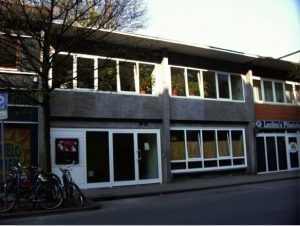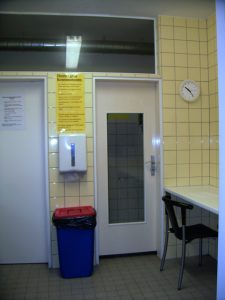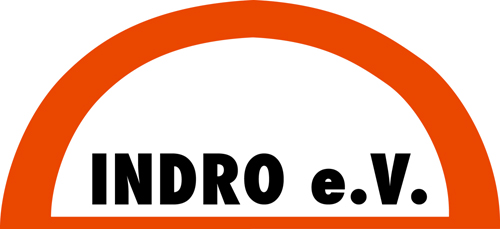Consumption and Injecting Room (CIR) at INDRO, Münster, Germany
Annual Report 2006 (abridged English version)
Ralf Gerlach and Wolfgang Schneider
© INDRO e.V., Münster, Germany, July 21, 2007
Introduction/background
The Institute for the Advancement of Qualitative Drug Research, Accepting Drug Work and Rational Drug Policies (INDRO e.V.) is a low-threshold facility which operates in Münster, a town in Northern Germany with a population of about 280,000 and a visible open drug scene of some 400 users – the estimated total number of heroin and/or cocaine users is 1,000 to 1,200, some 600 of whom are enrolled in substitution treatment. The majority of those participating in substitution treatment are treated with methadone [(other substances/medications used are buprenorphine (Subutex® and Suboxone®)].
All INDRO services are offered in a small one-storey building located some 150 metres off the central railway station and some 250 metres off one of the two open local drug scenes.
 |
 |
The CIR started to operate on April 10, 2001 and was the first German consumption and injecting facility operating in accordance with federal law (Narcotics Act of March 2000). It is integrated within a special ambulatory medical service and a low-threshold drop-in center. The CIR has a total of four open places for injecting (as can be seen on the pictures there are no booth-like partitions).
 |
 |
In addition, there is a separated booth with air exhaust for visitors smoking heroin or cocaine (“foil smoking” or “chasing the dragon”).
 |
 |
Service delivery is based on harm reduction, acceptance and anonymity. Therefore, the names of the CIR visitors are not registered. The CIR is open five days per week and its hours of operation are from 1100 to 1700 Monday to Thursday and from 1100 to 1600 on Friday.
According to the Regulation on the Operation of Consumption Rooms (ROCR) (Verordnung über den Betrieb von Drogenkonsumräumen) of the Federal State of North Rhine-Westphalia drug users are allowed to self-administer in the CIR their own ration of pre-obtained illegalised substances like opiates, cocaine, amphetamine or its derivatives, in their preferred manner of use [intravenous, oral, inhalative (smoking) or nasal use)], if they are of full age (at least 18 years old), dependent on one of the substances mentioned above and if they cannot be identified as patients participating in drug-substitution treatment. Drunk and intoxicated persons must not be admitted. The staff advise on (safe) injecting practices but must not assist injecting. Interesting enough, the use of black market methadone or buprenorphine is not prohibited by the ROCR while benzodiazepines must not be consumed.
The CIR staffers have been instructed to keep non-dependent users (obvious first-time or recreational users) from entering the CIR and to refer these visitors to other appropriate counselling and support services in the area, including other INDRO services. Drug-dependent persons under 18 years of age are only accepted for using the CIR if there is a (written) consent from their parents or if the drug workers have satisfied themselves, after careful examination of other possible support provisions in each single case, as to the firm decision of the adolescent to use drugs. The substances the users carry with them are subject to visual control. There are two staffers present in the CIR at all times, and all staff are trained to resuscitate users if they overdose.
Violations of the Narcotics Act, including dealing activities and drug sharing are strictly prohibited, except for possessing drugs in small quantities for personal use. Corresponding occurrences have to be stopped instantaneously by the provider of the CIR and have to be punished by house-bans. There are regular talks with the responsible health, public affairs and prosecution authorities (police and public prosecutors) of the city of Münster in order to prevent as early as possible disturbances of the public security and order and the committal of offences in the immediate neighbourhood of the CIR as well as to secure the low-threshold access to all INDRO services.
The following rules, put on the notice board of the CIR, are well noticeable for every visitor:
– dealing, passing on and sharing of drugs and injecting equipment is strictly prohibited
– drug use is only permitted in the CIR
– drug users must not assist one another injecting
– no violence and threats of violence to persons and objects
– no selling of stolen goods
– smoking tobacco as well as bringing in food and/or drinks (alcoholic and non-alcoholic) is prohibited.
After injecting, each user is supposed to clean his/her own place at the table and to dispose the used equipment. It is not allowed to assist others with injecting and users must only use the injecting equipment provided by the staff of the CIR. There is a maximum time limit for injectors (20 minutes) and foil smokers (15 minutes).
The CIR must not be promoted. However, specific target group information material, including safer-use info, is provided.
The CIR staffing is one doctor (half-time, 20 hours weekly), two social workers (one full-time, one half-time, 20 hours per week) and three medically trained workers [ two rescue medics (one half-time/one part-time, 10 hours per week) and one nurse (part-time, 8 hours weekly). Apart from the psychic burden the staff has to bear the amount of work and control involved is enormously high. The workload can be managed by rotation of staff, i.e. staff from other INDRO services (also trained in first aid) take turns with the CIR staffers. We could thus keep the annual overall costs for running the CIR down to some 125,000 € (Euro).
Summary of the most important data on the frequency of use of the CIR from 2002 to 2006
All CIRs operating in the federal state of North Rhine-Westphalia are research-evaluated by the state Ministry of Labour, Health and Social Affairs. There are forms designed for evaluation purposes that have to be filled in daily by the CIR staffers and sent to the Ministry every seven days. The documentation includes: using episodes, using patterns, age groups, persons rejected admission, support/assistance provided, referrals, special occurrences, bans and emergencies. Between January 1, 2002 and December 31, 2006 the CIR was open on 1,245 days (= 7,013 hours).
Using episodes, using patterns and substances used
On average, there were 51.4 using episodes daily from 2002 to 2006 with an average duration of stay of around 10 minutes with injectors and some 15 to 20 minutes with heroin or cocaine smokers. There was a total of 63,865 using episodes (men: 57,141; women: 6,724) – 63,865 using episodes that did not take place in public areas! The men-women ratio was about 8.4:1.
Table 1: using episodes 2002 – 2006
|
There were 47,674 intravenous using episodes (men: 43,143; women: 4,531).
Table 2: i.v. using episodes 2002 – 2006
|
Regarding inhalative use there was a total of 15,280 episodes.
Table 3: episodes of inhalative use 2002 – 2006
|
There were relatively few episodes of nasal (900) and hardly any episodes of oral (11) application.
Approximately 90% of the visitors of the CIR used heroin, 5% cocaine, 4% heroin/cocaine, 0.5% heroin/benzodiazepine and 0.5% cocaine/benzodiazepine mixtures (since we are not allowed to check drugs occasional use of benzodiazepines can not be prevented).
The decline in using episodes from 15,375 in 2002 to 10,985 in 2006 can primarily be explained by the fact that the number of patients participating in substitution treatment has risen from 450 in 2002 to some 600 in 2006 (as mentioned above, methadone or buprenorphine patients must not use the consumption room – according to the Regulation on the Operation of Consumption Rooms of the Federal State of North Rhine-Westphalia).
Age groups
Until now drug users under 18 years of age have not visited the CIR. The age groups used in table 4 have been set by the federal state evaluation team.
Table 4: age groups 2002 – 2006
|
Persons rejected
On the basis of the admission criteria given in the legislative framework of the ROCR, 845 (!) persons identified as patients participating in regular medically supervised drug substitution treatment had to be refused admittance to the CIR between 2002 and 2006 as well as 69 intoxicated visitors.
Support/assistance provided
Acute medical care was provided 8,774 times (e.g. wound dressings, treatment of abscesses, basic first aid). Psychosocial counselling was offered 2,772 times resulting in 212 referrals to specialised detoxification facilities, 200 referrals to GPs prescribing substitute substances (methadone, buprenorphine), more than 350 referrals to primary health carers, 261 referrals to agencies advising on in-patient, abstinence-oriented therapies (therapeutic communities) and 551 referrals to social welfare services. There were some 3,700 referrals to other INDRO services.
Bans
All in all, there were 206 bans, most of which were either pronounced because of risky using behaviour, such as drug- and needle-sharing, or because of passing on of drugs. No bans had to be pronounced because of attempted drug dealing.
Emergencies
There occured 603 emergencies due to overdosing while or after injecting (men: 539; women: 64), 88 of which were life-threatening conditions (respiratory depression, serious cardiovascular problems). Through immediate medical support provided by the CIR team and an ambulance together with an emergency doctor called (who, on average, arrived on-site within 5 minutes after being called) the life of these users, most of whom had to be taken to hospital, could be saved. By operating CIRs the likelihood of successful life-saving measures has been increased dramatically. CIRs provide shelter to drug using people and facilitate drug use under hygienic and medically controlled conditions.
Special occurrences
There occurred no case of (major) violence in the CIR which confirms our view that security staff need not be employed in the facility. The admission procedure, including clarification of the rules and entry criteria, signing an agreement* on the use of the CIR (no ID check, the ‘contract’ will be destroyed immediately after a user has left the CIR) and responding to questions for the statistical evaluation, has been explained to all regular users meantime so that there is usually a stress-free atmosphere in the entrance, waiting and injecting/consumption area. There occurred no congregation of drug users and dealers in front of our facility, no disturbances of the public order in the immediate neighbourhood as well as no honey pot effect. Occasional (exceptional) police actions in the neighbourhood of the CIR resulted in lower CIR using episodes, increased use in public places and a rise in emergencies outside the CIR.
Conclusions
The CIR has reached the target group of drug users from the visible public drug scene. Feared effects like congregation of drug users and dealers in front of the facility, nuisance of the public, drug dealing in the CIR or honey pot effects could have been avoided. The consumption and injecting facility has to be regarded as a health-preventive offer to minimize harm and to provide survival support in the context of the network of the entire drug-help system in Münster. In the CIR the pre-obtained drugs can be used under relatively safe (low-risk) and hygienic conditions, the rescue-likelihood concerning possible overdoses increases (many users’ lives could be saved), infection-prophylaxis can be provided and concentration of problems in the public (visible drug use and dealing, inappropriately discarded injecting equipment, congregation of a drug scene) is considerably reduced.
*Agreement between INDRO e.V. and the visitor on the use of the injecting room:
I assure to enter the injecting room only for the purpose of drug use, to keep to the rules and to follow the instructions of the staff.
I declare to have reached the age of 18 and to be drug-dependent. Currently I am not enrolled in medically supervised drug-substitution treatment.
I know that I am allowed to carry drugs with me only for the purpose of immediate personal use and that dealing, passing on and sharing of drugs is absolutely forbidden. Offences will immediately be punished with house-bans.
Münster, ……………
……………………………………………….
Signature of the user
INDRO e.V.
Bremer Platz 18-20
48145 Münster
Germany
Phone: +49 251-60123
Fax: +49 251-666580
Email: INDROeV@t-online.de
Back to index

